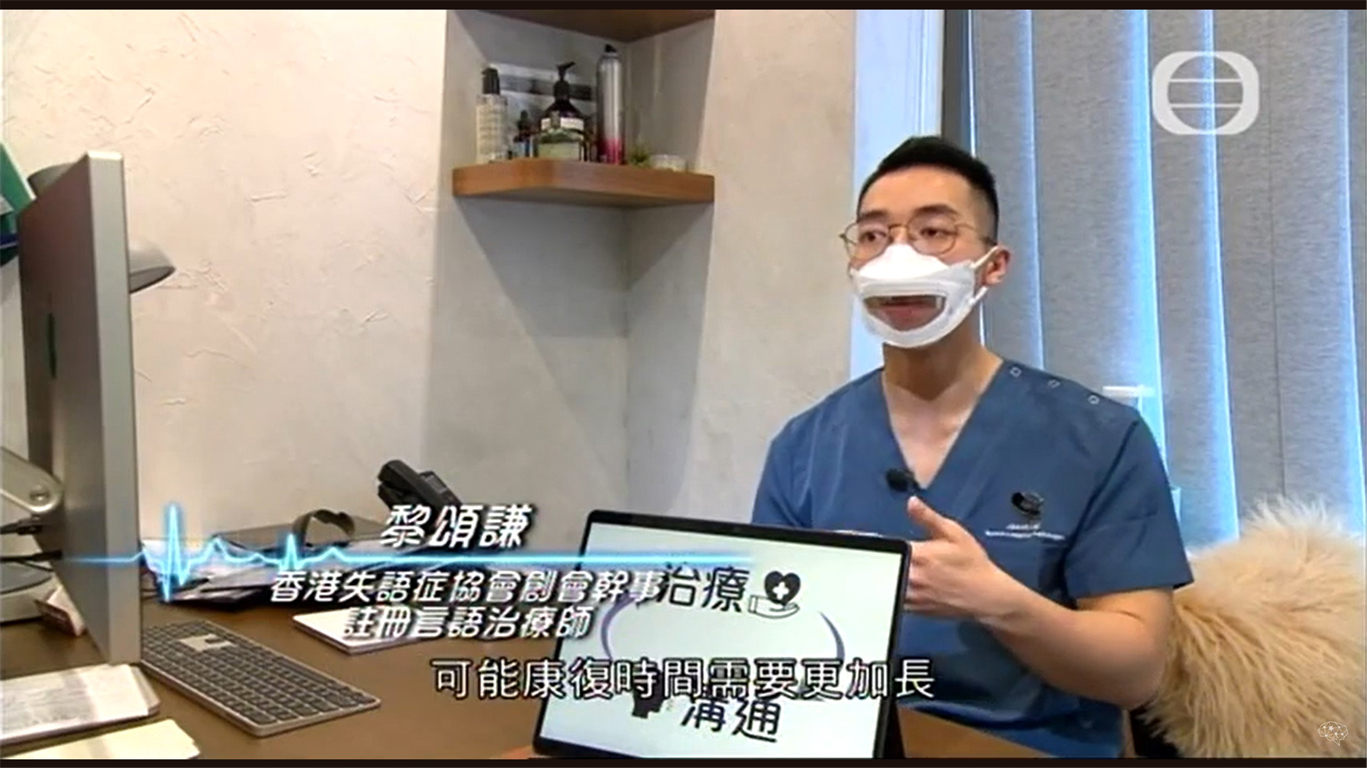Qualification
- BSc(Sp&HearSc) (HKU)
- Member of HKAST
- Member of Register of Speech Therapists accredited by Department of Health
Scope of Services
Assessment and Treatment – Communication, Cognition, Speech, Voice, and Swallowing Abilities
These issues may be caused by learning disabilities, accidents, or medical conditions, such as:
- (Cleft lip and palate) congenital defects
- Autism and Down syndrome (causes of delayed language development)
- Head and neck cancer
- Laryngopharyngeal reflux
- (Brain injury and stroke) neurological diseases
- (ALS, multiple sclerosis, Parkinson’s disease) neuromuscular diseases, (total laryngectomy, tracheostomy) trauma and surgery
- Vocal cord nodules/cysts/polyps
Services include:
- Speech assessment and therapy (stuttering, aphasia, apraxia of speech, dysarthria)
- Voice disorder assessment and therapy
- Clinical swallowing assessment
- Instrumental swallowing assessment
- Fiberoptic Endoscopic Evaluation of Swallowing (FEES): FEES involves inserting an endoscope through one nostril to systematically guide the patient in swallowing various types of foods and liquids of different textures, consistencies, and colors. This assessment can be performed during the evaluation stage, throughout treatment, or after treatment is completed. The purpose is to identify the patient’s swallowing weaknesses and sources of aspiration risk (i.e., “food going down the wrong way”). In addition, FEES helps to identify effective swallowing compensation strategies and assess whether it is appropriate to remove nasogastric tubes, gastrostomy tubes, or parenteral nutrition.
- Swallowing therapy
- Speech/swallowing disorders related to oral or head and neck cancer (after surgery and/or radiotherapy)
- Speech/swallowing disorders in individuals with tracheostomy or on ventilators
- Pill swallowing assessment
- IDDSI consultation and referral services
- Palliative feeding consultation services
Related Services
Head and Neck Cancer
Clinical OncologyGeneral SurgeryOtolaryngologyPlastic Surgery
Head and neck cancer is a collective term for cancers that occur in various upper respiratory tract tissues. Depending on the site of occurrence, it can be divided into oral cancer, nasopharyngeal cancer, oropharyngeal cancer, hypopharyngeal cancer, and laryngeal cancer. The most common tumour type in head and neck cancer is squamous cell carcinoma, which originates from squamous cells on the mucosal surface of the head and neck.
According to medical research, some head and neck cancers are associated with HPV (human papillomavirus).
Detail
Oral Cancer
Clinical OncologyGeneral SurgeryOtolaryngologyPlastic Surgery
The "oral" region comprises multiple sites, including the lips, tongue, floor of the mouth, hard palate, and gums, as well as the oral mucosa, buccal mucosa, and salivary glands. Any malignant tumour growing in these locations is collectively referred to as oral cancer, which is also one of the types of head and neck cancer.
Detail
Tonsillitis
Otolaryngology
Tonsillitis is a common throat disease, manifested by sore throat, fever, cough, etc. It requires treatment and prevention.
Detail
Laryngopharyngeal Reflux (LPR)
Otolaryngology
Laryngopharyngeal Reflux (LPR) is inflammation of the throat and vocal cords caused by the backflow of stomach acid or other stomach contents into the throat. Patients may experience throat irritation, difficulty swallowing, increased phlegm production, coughing, vocal fatigue, and hoarseness.
Detail
Vocal Nodule
Otolaryngology
Vocal cord nodules, commonly known as vocal cord calluses, vocal cord nodules or singer's nodules, are benign growths or nodules on the vocal cords. They typically appear at the contact points of the vocal cords, which are the areas that vibrate the most during phonation. These nodules are primarily caused by excessive or improper use of the vocal cords, leading to inflammation and swelling, and eventually, the skin thickens and forms nodules.
Detail
Vocal Polyp
OtolaryngologyPlastic Surgery
Vocal Polyp is a benign tumour that develops on the vocal cords, typically appearing as a soft mass on one side of the vocal cord mucosa. These masses can be translucent, vascular, or sometimes present as thicker tissue. It is differ from vocal nodules, which usually appear symmetrically on both sides of the vocal cords.
Detail
Vocal Fold Cyst
Otolaryngology
Vocal Fold Cyst is a benign cystic structure that forms on the vocal cords, typically located in the submucosal layer of the vocal cord. These cysts can form due to the blockage of a mucus gland in the vocal cord, leading to the accumulation of glandular secretions and the development of a cyst. Vocal cord cysts are usually unilateral (affecting one side) and can interfere with the vibration of the vocal cords, thereby affecting the quality of the voice during speaking and singing.
Detail










.jpg)



